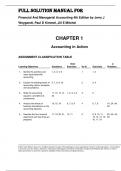Examen
SOLUTION MANUAL FINANCIAL AND MARGINEL ACCOUNTING 4th EDITION By JERRY. J. WEYGANDT , PAUL. D. KIMMEL, JILL .E. MITCHEL 2023
- Cours
- Établissement
© 2021 John Wiley & Sons, Inc. All rights reserved. No part of this publication may be reproduced, stored in a retrieval system, or transmitted, in any form or by any means, electronic, mechanical, photocopying, recording or otherwise, except as permitted by law. Advice on how to obtain permissi...
[Montrer plus]



